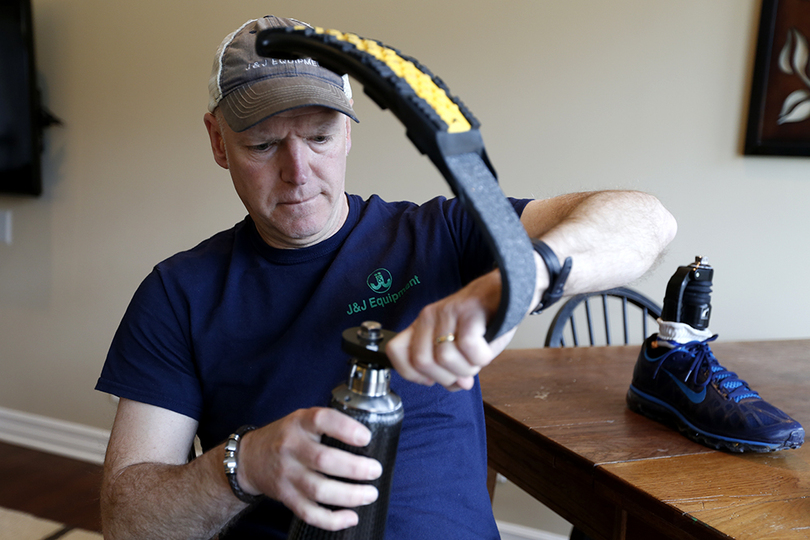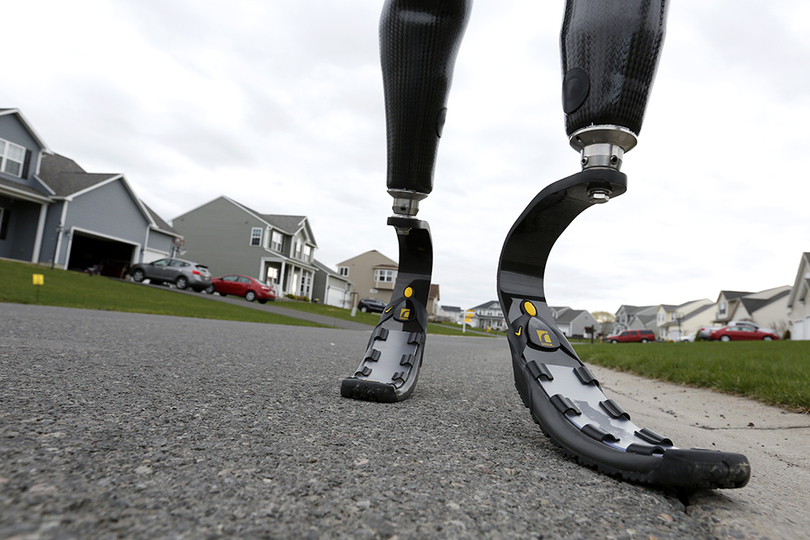Local resident reflects on injuries, recovery from snowmobile accident
George Lonergan begins to jog past his home in Cicero, New York. A smile crosses his face. It’s about 40 degrees outside and he wears shorts, a pullover and his company’s hat. His feet smack against the pavement and spring back up. This is George Lonergan.
He is a runner. And he’s lucky to be alive.
It’s harder than it used to be. The pace is slower and it’s not as natural. The energy he spends running now is about three times as much as he did before the accident. Doctors say he could be faster.
“It’s just a matter of how brave I am,” Lonergan said. He hasn’t gotten the confidence back. It’s a work in progress.
Lonergan was involved in a serious snowmobiling accident in December 2013 — one that forced both of his legs to be amputated. He spent four days in a medically-induced coma after his lungs failed as a result of the accident.
Now, more than a year and a half later, he remains on the road to recovery and running is his gateway. He will speak at the 2015 Syracuse Sport Summit on Thursday, an event that aims to spark discussion about the integration of disabled citizens into the community through the use of adaptive sports.
**
Lonergan compares the snowmobile accident to crashing a Ferrari.
“But I’m starting to get a little bit of the Ferrari back in these puppies,” he said, dangling his prosthetic legs.
It was a snowy mid-December night in Old Forge, New York. The Lonergans were doing a popular family winter activity — snowmobiling. They were riding their snowmobiles around on the trails surrounding Old Forge. When heading home from a restaurant, George Lonergan was going too fast on a dark trail, he said.
He went off the trail and hit a rock covered in snow, which threw him over the handlebars of his snowmobile and into a ravine-like area.
Both his lower leg areas were crushed beyond repair. His right leg was broken in 14 different places and his left in 12. Three of his ribs were broken and one punctured his lung, causing it to collapse. The accident took place close to the main road so an ambulance was able to quickly get him to the hospital. He never lost consciousness and was able to talk to the EMT during the ride. However, he had no idea of the serious damage done to his legs.
“Your body has a way of disguising the pain, I guess, when it’s that bad,” he said.
But at the hospital, his right leg was amputated the same night as the accident. He spent four days in a coma. On Christmas Eve, 10 days after the accident, his left leg was amputated. He spent a total of 23 days in the hospital.
The doctors said he shouldn’t be alive. Lonergan knows this.
“Just very, very lucky,” he said in a quiet voice, almost a whisper.
**
“David and Goliath” by Malcolm Gladwell sits on a coffee table in Lonergan’s home. While it’s his wife, Carol, who’s read it, the book symbolizes George Lonergan’s quest.
A few years after starting his now six-employee street sweeper business in 2001, he began to run. He had hit the age of 40 and wanted to get in better shape.
“Always could run, but I never really ran,” he said.
During that time he was visiting his wife’s sister in Connecticut. After signing up for an Easter 5K, Lonergan started in the back of the pack, but wound up passing other runners, crossed the finish line and thought: “Wow, this is pretty cool.”
Things began to take off then. He began to run more and more — up to five or six days every week and 25-30 miles over that time frame. He wasn’t specifically training to run a marathon, but rather to stay in shape and to run in “whatever races came along.”
But the plan was to run a marathon. Then the accident happened.
“Now those plans are…” he pauses. “Those plans were on hold for a while.”
The first step was the prosthetic legs. He spent a few months in a wheelchair before his first pair of prosthetic legs.
“For me it’s been pretty easy getting used to walking on them,” he said, showing the ins and outs of how the legs operate. “They’re not the most comfortable things, not the most comfortable at all. I still have a tremendous amount of discomfort where my legs slide into them.”
Earlier this year Lonergan got a set of prosthetic running shoes, which he enjoys showing off. They even have Nike logos on them. Now he runs 2–3 times a week. He can’t run as far or as long as he could pre-accident. But it’s the baby steps that count.
**
Lonergan doesn’t read motivational books. Friends and family would give him the books, but he didn’t and still doesn’t have interest.
He did, however, start reading one of the books written by a retired athlete. It didn’t last long.
“I took the book, read the first few pages and then threw it on the couch,” he said. “I don’t need any motivational book. I just lost both of my legs in an accident and I’m going to read a book to give me motivation to carry on with my life? It’s all got to come right here and right here,” he said, pointing to his head and then his heart.
The self-motivation makes him want to run. On this day he runs for only a short period of time — down part of the street and back. He’s had moments of self-grief, but today is not one of them. He’s running. It’s not as easy, but he’s running.
“I didn’t realize it was going to be as hard as it is going to be to run and run like how I want to run,” he said. “I guess I was like ‘I’ll just get these running legs on and I’ll just be the old George.’ And that’s still a possibility but that’s going to take a lot of hard work.”
Published on April 28, 2015 at 12:02 am
Contact Justin: jmatting@syr.edu | @jmattingly306







